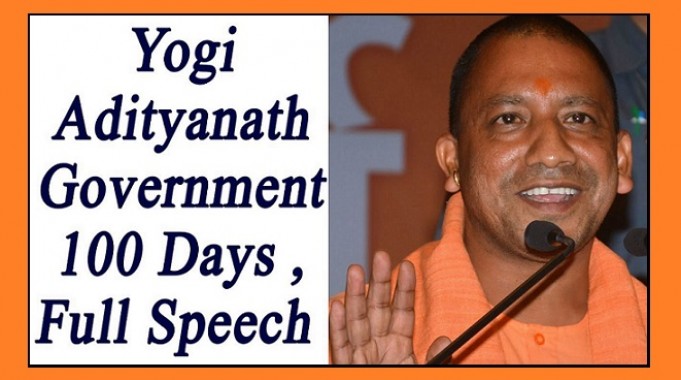Yogi’s first 100 days: poor, average or good?
The ability to shift goal posts without much public scrutiny has been key to the success of the BJP ever since it came to power in 2014. The media, for its part, has failed to adopt stable criteria to judge its performance. During the assembly election campaign in Uttar Pradesh, newspapers highlighted the issue of caste and regional representation. After the declaration of the results, the focus shifted to the representation of religious minorities. Three months later, all these were completely forgotten and the coverage focused on the personality of Chief Minister Yogi Adityanath and fleetingly covered the government’s performance vis-à-vis the key issues.
This article analyses the coverage of the Adityanath government’s performance in the Lucknow edition of two Hindi newspapers - Amar Ujala (Ujala ) and Dainik Jagran (Jagran) - and two English newspapers - The Indian Express (Express) and The Economic Times (ET) - between June 25 and June 30 and also coverage by their websites.
Personality-centric coverage
All four newspapers restricted their attention to Adityanath, except for brief coverage of the two deputy CMs in Jagran and ET. It is as if ministers, MLAs, and party functionaries did not matter at all. Did the focus on Adityanath mean an in-depth scrutiny of his performance? The BJP could not have asked for more adulatory coverage.
Express and ET, which carried a common PTI story, noted that “Adityanath has proved himself to be a tough taskmaster, holding back-to-back meetings with ministers and bureaucrats well past midnight, only to return to office before 9.30 the next morning.”
What was achieved? An “unusual sight”(“the parking lots at the secretariat here get full even before the clock strikes 9:25 in the morning”). Jagran went a step further and declared that he had unleashed a “new revolution” (naikranti) the day he stepped into the secretariat.
Jagran praised the CM’s sensitive attitude in the Janata Darbars and argued that he enjoyed the trust of the people (“within a few hundred days, about 22 lakh complaints were registered in the CM public grievance redressal meeting”). Ujala presented the installation of biometric attendance tracking systems for civil servants as a harbinger of change.
With so much focus on Adityanath, did the newspapers at least capture his divisive image? Barely a week after he said that the Taj Mahal is not part of Indian culture, Ujala highlighted his sensitivity (samvedansheelta) towards cultural issues. What is even more interesting is that building roads between a few pilgrimage towns was the measure of cultural sensitivity.
Express was relieved that Adityanath avoided controversies (“the appointment of Adityanath as chief minister raised many eyebrows considering his communal beliefs and his hate speeches in the past. But he didn’t repeat those mistakes . . . [and] conducted himself in a manner completely opposite to the expectation”). Perhaps for the Express, his statement on the Taj Mahal is not controversial and does not reflect his communal beliefs. However, it did publish a cartoon on his Taj Mahal statement (June 28).
Who is responsible for failures?
But who was responsible for the repeated outbreaks of violence between communities and for crimes? Ministers or MLAs? To be held responsible, they would have to be given some space, which would disrupt the single-minded focus on the CM.
The faceless bureaucracy and police emerge as the scapegoats. Bureaucrats were blamed by Jagran (“Irado ki rafter me kanun vyavstha ka roda”) and Ujala for the government’s failures and the attendance problem was highlighted as an example of all that was wrong with the bureaucracy. Even ET and Express found the bureaucracy lacking and noted that “Law-and-order and governance, however, remain the primary challenges for Adityanath. It will be a herculean task to change the attitude of the bureaucracy down to the lowest level and make the government machinery responsive to the needs of the public, political observers feel.”
In short, everyone except Adityanath was responsible for the government’s shortcomings, if any.
What did he achieve in his first 100 days?
The focused coverage of Yogi’s personality was accompanied by light coverage of issues and policies. On June 27, the UP government released a report card of its performance during the first 100 days. Given the BJP’s campaign promises and the CM’s divisive personality, it was expected that the government’s self-assessment would attract a lot of attention.But all four newspapers assessed the performance before the government shared its own report card and merely covered the release of the latter without critically analysing the claims.
The headlines used by the Hindi newspapers were appreciative: (Jagran - “Faisle lene vali Sarkar,” A government that takes decisions; Ujala - “Badalav par raftar dheemi,” Change but pace slow) while Express used a dull headline (“100 days of Yogi Adityanath government: Here are the major developments,” on its website).
ET published an analysis with obliquely critical different titles, highlighted the undiluted commitment to Hindutva coupled with the focus on development (“Development, but no compromise on core Hindutva values: Yogi government's 100-days report card,” website), and mentioned industry (“Yogi Bats on Front Foot for Industry, Keeps Core Intact,”print). Note that the title of the web item identifies Hindutva as an issue.
The divide between Hindi and English
In the rest of this article, we will compare the assessment of Adityanath’s policies in these newspapers and the divide between the Hindi and the English newspapers.
On some issues, for example land grab, newspapers reported the claims of the government but did not investigate further. However, on the fuel pump scam, newspapers highlighted the government’s failure to pursue the case (Express, Jagran, and Ujala). On most other issues such as women’s safety, law and order, loan waivers, and illegal slaughterhouses, there were systematic differences between the Hindi and the English press.
All newspapers questioned the government’s claim of improving women’s safety. Express noted “the government had to order the [anti-Romeo] squads formally to restrain themselves from moral policing” due to criticism. Ujala noted the involvement of Hindutva organisations in targeting couples. However, in a report from Unnao district, Jagran pointed out the suffering of women in the absence of anti-Romeo squads on the ground was due to an insufficient police force, especially of policewomen.
Law and order was highlighted by all newspapers, but there was a divide between the Hindi and the English newspapers on inter-caste and communal conflicts. The PTI story carried by both ET and Express highlighted divisions within the right wing: “The Bulandshahr incident took place even as Adityanath met senior Yuva Vahini workers during a visit to Gorakhpur and warned them against taking law in their own hands.”
The Hindi newspapers did not take note of the communal violence in Bulandshahr while assessing the government’s performance. As to caste violence, unlike the Hindi newspapers that did not identify the specific castes involved, the English newspapers highlighted that the fact that it was a Thakur-Dalit clash and that Adityanath belonged to the former caste.
Both the Hindi newspapers blamed the police administration for these incidents, but Jagran also noted the role of the local BJP MLA in the unrest in Saharanpur. Jagran alone published two editorials on infrastructure and law and order.
So, all the newspapers agreed that the government had not been entirely successful in maintaining law and order but they differed on who was responsible.
The Hindi and the English newspapers also differed in their assessment of the loan waiver for farmers. A PTI story carried by both ET and Express noted that “The government has not announced any major scheme or big-ticket infrastructure projects other than the farm loan-waiver” and that the loan waiver was a “sudden fiscal burden.”
An ET editorial criticised the promise of a loan waiver by the BJP during the election: “Winning elections is important for politicians. At any cost is their motto”.
Express noted that “The move was touted as populist and a quick fix measure to win brownie points. Nevertheless, the beneficiaries amounted to around 85 lakh small farmers.”
The Hindi papers saw it differently. Ujala and Jagran viewed the loan waiver as a major decision taken under difficult financial conditions. Ujala also raised other issues like the unpaid bills of sugarcane farmers and land acquisition.
English newspapers questioned the government’s achievements in the field of infrastructure. ET underscored the less-than-satisfactory performance by pointing out that “Yogi does have a luxury that Akhilesh didn't - a supportive centre. Sensing UP's financial crunch, a massive roads package was granted to UP recently.”
Likewise, Express suggested that the government’s report card “lists three infrastructure projects of SP, BSP govt.” However, Ujala pointed out that previous governments did not show interest in utilising project funds from the central government, while the new government had taken steps to avail itself of funds for electricity, health ambulances and road construction.
Jagran’s editorial (“Jewar se udan”, Flight from Jewar) highlighted the enormous delay in the Jewar airport project under previous governments due to centre-state political conflicts.
In short, the English newspapers questioned the government’s lacklustre effort on infrastructure development, while the Hindi newspapers blamed the previous governments.
Regarding the promise of pothole free roads within 100 days, ET and Express pointed out that "The government itself has admitted it could manage to make just 63 per cent of the state roads pothole-free by the June-15 deadline set by the chief minister". Ujala partly agreed with the government’s claim regarding repair of potholes in urban areas, but completely disagreed in the case of rural areas.
None of the four newspapers discussed industrial development in their Lucknow editions. Ujala questioned the government on this in its Noida edition. Express and ET provided only limited coverage on Yogi government's 100 days in print, with their websites providing relatively greater coverage. Basic issues like electricity, health, and education were not discussed in the English newspapers.
Among the core Hindutva issues, only the closure of illegal slaughter houses was highlighted. The government claimed success in checking illegal slaughter houses, while the newspapers were divided.
Ujala questioned the government for not implementing its promise to ban illegal slaughter houses, while Express highlighted the negative impact of the ban on the butcher community and meat traders. Ujala therefore felt that the government had failed to fulfil its promise, while Express felt that whatever was done was harmful.
The only clear comment on the government’s Hindutva orientation appeared in ET, which noted that: “The CM promised them [Sangh associates] that existing anti-cow slaughter and anti-conversion laws in the state will be strengthened, 'reforms' will be brought to education and no new slaughter houses would be allowed to open. Same day, in Ayodhya, two trucks filled with 130 tonnes of stones from Rajasthan arrived at VHP's temple workshop, Karsevakpuram . . . But Yogi, who has offered to mediate between the parties for construction of the Ram Temple, lifted this unofficial stop work order [of the Akhilesh Yadav government].”
Hindi newspapers took advantage of their vast network of editions in adopting a different scale of criticism. For instance, Jagran published a highly critical report in the Ghaziabad edition (“Jamhuriyat ki peer samajhkar hi taza rahengi kamal ki pankhudiyan”, The lotus will remain fresh only if it understands the pain of the people).
It began with a quote from the poet Adam Gondvi - (“Aankh par patti rahe aur akl par tala rahe, apne shahe-vakt ka yun martaba ala rahe, ek jansevak ko duniya me ‘adam’ kya chahiye. Char-chah chamche rahe, mike rahe, mala rahe”) With blindfolds and locks on their minds, they while away their royal time. What else does a servant of the people want in the world – a few flatterers, a mike, and a garland, and questioned the aloofness of the BJP from the grassroots.
Likewise Jagran’s cartoons were quite critical of the government’s performance and were focused on issues that directly affected people, unlike the Express cartoons that focussed on Adityanath’s personality.
|
Cartoons published in Express (upper row) and Jagran (lower row) during 100 days |
||
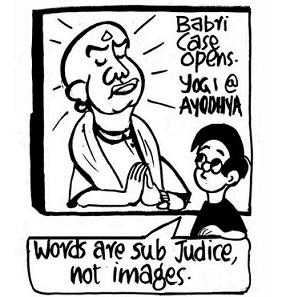 |
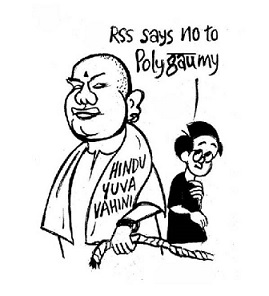 |
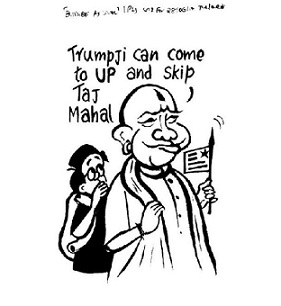 |
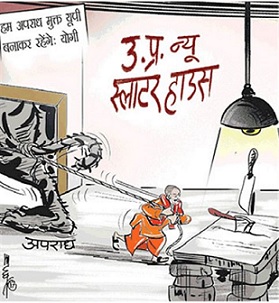 |
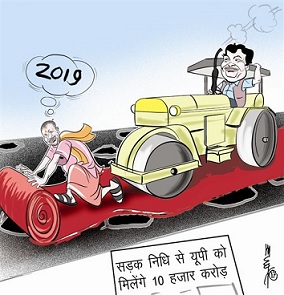 |
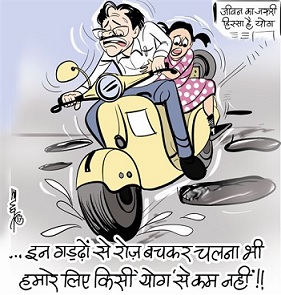 |
To conclude, while the government did not receive much criticism on the completion of 100 days in the four newspapers, there were clear differences between the Hindi and the English newspapers in their assessment of infrastructure, social conflict, closure of illegal slaughterhouses, and the farm loan waiver. Express and ET published the same PTI story on June 18, which narrowed down the differences between their coverage.
The Hindi newspapers not only covered more issues in comparison to the English newspapers, but also reported more achievements. They were more likely than their English counterparts to blame the bureaucracy and police for the failures of the government.
Ankita Pandey is an independent researcher based in Bengaluru.







